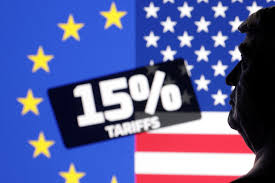
European Union and United States officials unveiled a comprehensive trade framework aimed at deepening economic ties and eliminating the threat of escalating tariffs. Under the agreement, most industrial and consumer goods will now face a uniform 15 percent import duty, significantly lower than the previously threatened 30 percent levy. In exchange, the EU has pledged to purchase U.S. energy, machinery, and defence equipment worth hundreds of billions of dollars, and both sides have committed to tackling non‑tariff barriers across multiple sectors.
Key Provisions and Sectoral Coverage
The new deal applies a 15 percent tariff to a broad swathe of products, including automobiles, semiconductors, chemicals, and pharmaceuticals. Notable exclusions cover critical industries: aircraft and aircraft parts will remain tariff‑free pending a joint review; certain agricultural staples—such as cheese, olive oil, and fruit—will benefit from zero duties under newly expanded tariff-rate quotas; and essential raw materials, like rare earths and semiconductor equipment, are exempted entirely. Steel and aluminum tariffs, set at 50 percent since 2018, remain in place for now, although both sides have agreed to explore quota‑based alternatives.
A separate annex addresses digital trade and data flows, ensuring that American tech firms can operate in Europe with minimal restrictions, while the EU gains greater access to U.S. cloud and cybersecurity services. Commitments on regulatory cooperation will see the two economies align product standards over the next two years, simplifying market entry for small and medium‑sized enterprises. Sustainability chapters introduce joint oversight of environmental and labor standards, including measures to curb deforestation‑linked commodities and to enforce worker protections in supply chains.
Investment and Market‑Opening Commitments
Brussels has pledged to invest some $600 billion in U.S. infrastructure projects—spanning renewable energy plants, broadband expansion, and smart‑grid technologies—over the coming decade. Meanwhile, Washington commits to purchasing up to $150 billion in European aerospace and defence equipment, including helicopters, drones, and naval surveillance systems. These procurement pledges are aimed at balancing trade flows and supporting strategic industrial collaboration.
Automakers stand to gain from phased reductions in technical barriers: the EU will recognize U.S. safety and emissions testing protocols for passenger vehicles, trimming months off approval times, while the U.S. will ease rules on Euro‑standard diesel engines for certain classes of commercial trucks. The deal also unlocks new quotas for EU spirits—such as Scotch whisky and Cognac—allowing greater annual exports without facing additional duties, though precise volumes will be finalized in the coming months.
Mechanisms for Enforcement and Review
A joint Trade Committee, co‑chaired by EU and U.S. trade commissioners, will meet quarterly to monitor compliance, address disputes, and expand product coverage. Both sides have agreed to a sunset review after three years, at which point tariff levels and excluded categories will be reassessed. Fast‑track arbitration panels are created to handle urgent trade conflicts, with rulings enforceable within 60 days.
For the steel and aluminum sectors, negotiators left open the possibility of introducing annual quota ceilings tied to import volumes and domestic demand. Should either party fail to meet investment or procurement commitments, the other side retains the right to reimpose higher duties. A series of working groups will examine digital taxation, customs procedures, and intellectual property protections, aiming to establish mutual recognition agreements for faster cross‑border trade.
Government leaders from both sides heralded the deal as a landmark achievement. In Brussels, the European Parliament’s trade committee welcomed the reduction of duties and the prospect of greater market access, though opponents cautioned that the 15 percent tariff remains burdensome for some industries. In Washington, Congressional supporters highlighted the energy‑sector gains and the commitment to renewables investments, while critics raised concerns about preserving domestic steel jobs.
Industry associations issued statements of cautious optimism. Automakers praised the streamlining of homologation processes but warned that full benefits will depend on swift implementation of regulatory harmonization. Farm groups emphasized the importance of the new agricultural quotas but urged negotiators to expand long‑standing exclusions for sensitive crops. Technology firms lauded provisions on data openness and cybersecurity cooperation, seeing them as a template for future digital partnerships.
Financial markets reacted positively: the euro strengthened against the dollar, reflecting investor confidence in stabilized trade relations, and shares in major exporters ticked higher. Analysts predict that trimmed tariffs and simplified standards could boost transatlantic trade by up to 10 percent over the next five years, adding tens of billions of dollars to annual GDP on both sides.
With the framework now agreed, negotiators will draft the detailed implementing texts, due for ratification by year‑end. Industry stakeholders have been invited to comment on sector‑specific schedules, and national parliaments will review the accord next spring. Observers note that while the headline tariff rate holds steady at 15 percent, the true measure of success will hinge on effective enforcement, the resolution of steel and aluminum duties, and the expansion of market‑opening measures into services and digital trade.
As global supply chains evolve and geopolitical uncertainties persist, the U.S.‑EU trade framework sets a new precedent for large‑scale economic cooperation. By locking in mutual concessions and creating robust oversight mechanisms, both sides aim to avert future trade clashes and deepen an alliance that underpins nearly a third of world commerce.
(Source:www.reuters.com)
Key Provisions and Sectoral Coverage
The new deal applies a 15 percent tariff to a broad swathe of products, including automobiles, semiconductors, chemicals, and pharmaceuticals. Notable exclusions cover critical industries: aircraft and aircraft parts will remain tariff‑free pending a joint review; certain agricultural staples—such as cheese, olive oil, and fruit—will benefit from zero duties under newly expanded tariff-rate quotas; and essential raw materials, like rare earths and semiconductor equipment, are exempted entirely. Steel and aluminum tariffs, set at 50 percent since 2018, remain in place for now, although both sides have agreed to explore quota‑based alternatives.
A separate annex addresses digital trade and data flows, ensuring that American tech firms can operate in Europe with minimal restrictions, while the EU gains greater access to U.S. cloud and cybersecurity services. Commitments on regulatory cooperation will see the two economies align product standards over the next two years, simplifying market entry for small and medium‑sized enterprises. Sustainability chapters introduce joint oversight of environmental and labor standards, including measures to curb deforestation‑linked commodities and to enforce worker protections in supply chains.
Investment and Market‑Opening Commitments
Brussels has pledged to invest some $600 billion in U.S. infrastructure projects—spanning renewable energy plants, broadband expansion, and smart‑grid technologies—over the coming decade. Meanwhile, Washington commits to purchasing up to $150 billion in European aerospace and defence equipment, including helicopters, drones, and naval surveillance systems. These procurement pledges are aimed at balancing trade flows and supporting strategic industrial collaboration.
Automakers stand to gain from phased reductions in technical barriers: the EU will recognize U.S. safety and emissions testing protocols for passenger vehicles, trimming months off approval times, while the U.S. will ease rules on Euro‑standard diesel engines for certain classes of commercial trucks. The deal also unlocks new quotas for EU spirits—such as Scotch whisky and Cognac—allowing greater annual exports without facing additional duties, though precise volumes will be finalized in the coming months.
Mechanisms for Enforcement and Review
A joint Trade Committee, co‑chaired by EU and U.S. trade commissioners, will meet quarterly to monitor compliance, address disputes, and expand product coverage. Both sides have agreed to a sunset review after three years, at which point tariff levels and excluded categories will be reassessed. Fast‑track arbitration panels are created to handle urgent trade conflicts, with rulings enforceable within 60 days.
For the steel and aluminum sectors, negotiators left open the possibility of introducing annual quota ceilings tied to import volumes and domestic demand. Should either party fail to meet investment or procurement commitments, the other side retains the right to reimpose higher duties. A series of working groups will examine digital taxation, customs procedures, and intellectual property protections, aiming to establish mutual recognition agreements for faster cross‑border trade.
Government leaders from both sides heralded the deal as a landmark achievement. In Brussels, the European Parliament’s trade committee welcomed the reduction of duties and the prospect of greater market access, though opponents cautioned that the 15 percent tariff remains burdensome for some industries. In Washington, Congressional supporters highlighted the energy‑sector gains and the commitment to renewables investments, while critics raised concerns about preserving domestic steel jobs.
Industry associations issued statements of cautious optimism. Automakers praised the streamlining of homologation processes but warned that full benefits will depend on swift implementation of regulatory harmonization. Farm groups emphasized the importance of the new agricultural quotas but urged negotiators to expand long‑standing exclusions for sensitive crops. Technology firms lauded provisions on data openness and cybersecurity cooperation, seeing them as a template for future digital partnerships.
Financial markets reacted positively: the euro strengthened against the dollar, reflecting investor confidence in stabilized trade relations, and shares in major exporters ticked higher. Analysts predict that trimmed tariffs and simplified standards could boost transatlantic trade by up to 10 percent over the next five years, adding tens of billions of dollars to annual GDP on both sides.
With the framework now agreed, negotiators will draft the detailed implementing texts, due for ratification by year‑end. Industry stakeholders have been invited to comment on sector‑specific schedules, and national parliaments will review the accord next spring. Observers note that while the headline tariff rate holds steady at 15 percent, the true measure of success will hinge on effective enforcement, the resolution of steel and aluminum duties, and the expansion of market‑opening measures into services and digital trade.
As global supply chains evolve and geopolitical uncertainties persist, the U.S.‑EU trade framework sets a new precedent for large‑scale economic cooperation. By locking in mutual concessions and creating robust oversight mechanisms, both sides aim to avert future trade clashes and deepen an alliance that underpins nearly a third of world commerce.
(Source:www.reuters.com)





